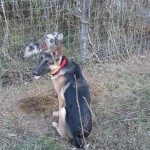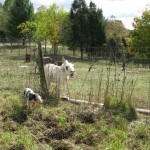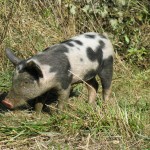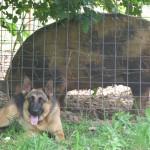This is an interesting and funny story about how a pig ended up at our farm. We are not talking about one of those small pot-bellied pigs but a 450-lb Yorkshire sow! Of course, the pig was only about 20 lbs when we first saw her being chased by our two mustang horses in the pasture. Initially I wasn’t sure what they were chasing because you normally don’t see pigs running around the countryside! Later I discovered that the pig had escaped from our neighbor’s pen. He had recently purchased the pig as a pet for his daughter.
I contacted my neighbor and we devised a plan to capture the pig. Not being a pig expert, the plan seemed reasonable to me. Let the horses drive the pig from the pasture. My neighbor would then use his fishing net to throw over the pig. After several futile attempts, a pair of broken glasses, and a bruised knee (not to mention our bruised egos), the pig ran off into the woods. During the next two weeks we kept hearing reports of a pig traveling up and down the road in front of our house. In one case, someone mentioned that they had almost hit a pig while driving! Apparently the pig would use the road to find shelter in our woods in the evening and then reappear in the morning to do what pigs do best–pig rooting! Unfortunately for the pig, she was rooting our neighbors’ lawns. We figured it would not be long before she would end up on a spit over one of my neighbors’ evening campfires. Besides, a pig this smart had to be saved!
We built a small fenced enclosure and lured the pig inside during one of her daily excursions. We have had her ever since. Over time, we have grown to admire Ms. Piggie for her resourcefulness and intelligence. She is very gentle and even puts up with those crazy geese who regularly invade her house.
Pigs will eat most of your kitchen scraps and leftovers. She is particularly fond of pasta and goat milk, which we mix with a special blend of corn, soya meal and molasses. For parasite control, we occasionally add Safe-Guard (Panacur) dewormer (controls both roundworms and whipworms) in pellet form to her food (Kent Feeds). Containment and housing are sometimes a challenge. We have found by trial and error that the best option for housing is a 6×5-foot culvert secured with two metal T-posts on each side. The pig will build her own nest within the culvert. Just toss a few flakes of hay or straw into her pen and she will carry them (by mouth) into the culvert. You can use pig or goat panel for fencing; however, she has never tried to escape. I suppose she knows what awaits her on the outside.
After Ms. Piggie did so well on her own for several weeks, we began to wonder if domestic pigs bred for meat production could survive in this area as feral animals. Pigs are very adaptable and, as omnivores, could easily find food in the pastures and forests. As some of you might know, feral pigs are relatively common in the U.S., e.g., southern U.S., California and New England. However, these are invasive species, the result of crossbreeding between domestic pigs brought by the Spaniards to the Americas in the 1400 and 1500s, and wild boars introduced from Eurasia. They are smaller in size (100-200 lbs) than their domestic counterparts and more aggressive in nature.
Here are some pictures of Ms. Piggie as a piglet and later as a full grown pig (properly called a hog). I will add a few more images to the gallery when it’s a bit warmer.
- With Gus, soon after coming to farm
- With Silver, our miniature jack
- Several months after coming to farm
- With Gus, at 2 years of age




